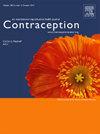Pandemic changes in U.S. contraceptive use: National survey estimates reveal significant differences by demographic subgroups
IF 2.3
2区 医学
Q1 OBSTETRICS & GYNECOLOGY
引用次数: 0
Abstract
Objectives
The COVID-19 pandemic brought multiple simultaneous consequences, with high potential to change fertility-related behaviors. We use nationally representative sex and contraceptive use event history calendar measures to demonstrate person-specific changes in contraceptive use after the pandemic, showing differences across demographic subgroups.
Study design
We use data from the first nationally representative web survey of U.S. fertility, fielded in 2020–2022: the American Family Health Study (AFHS). Using responses from 1357 female-identifying respondents ages 18–49, we analyze 26,274 person-months of sex and contraceptive use data spanning directly before and after the beginning of the pandemic to detect change.
Results
Individual-level hazard models of starting and stopping contraception revealed no pandemic-related changes in starting contraception, but significant reductions in the rate of stopping contraception for specific subgroups. Hispanic females reduced their rates of stopping contraceptive use during the pandemic (lowering their odds of stopping use by 71%), ultimately behaving more similarly to individuals from other racial or ethnic subgroups. Additionally, those aged 41 and older significantly reduced their rates of stopping contraceptive use (lowering their odds of stopping use by 78%) relative to other age groups.
Conclusions
Sudden large-scale health policy changes can produce significant changes in contraceptive use behaviors. The COVID-19 changes interacted with race, ethnicity, and age to produce different changes in contraceptive behaviors among different subgroups of the U.S. population.
美国避孕药具使用的大流行变化:全国调查估算显示不同人口亚群之间存在显著差异。
目标:COVID-19 大流行同时带来了多种后果,极有可能改变与生育相关的行为。我们使用具有全国代表性的性别和避孕药具使用历史事件日历测量数据来展示大流行后避孕药具使用的特定个人变化,并显示不同人口亚群之间的差异:我们使用的数据来自 2020-2022 年开展的首次具有全国代表性的美国生育率网络调查:美国家庭健康研究(AFHS)。我们利用 1,357 名 18-49 岁女性受访者的回答,分析了大流行开始前后 26,274 人月的性生活和避孕药具使用数据,以检测变化情况:开始和停止避孕的个人水平危险模型显示,开始避孕的人数没有发生与大流行相关的变化,但特定亚群的停止避孕率显著下降。西班牙裔女性在大流行期间降低了停止使用避孕药具的比率(停止使用的几率降低了 71%),最终表现与其他种族或民族亚群的个人更为相似。此外,与其他年龄组相比,41 岁及以上的人群停止使用避孕药具的比例明显降低(停止使用的几率降低了 78%):结论:突如其来的大规模卫生政策变化会对避孕药具使用行为产生重大影响。COVID-19 的变化与种族、民族和年龄相互作用,在美国人口的不同亚群中产生了不同的避孕行为变化:
本文章由计算机程序翻译,如有差异,请以英文原文为准。
求助全文
约1分钟内获得全文
求助全文
来源期刊

Contraception
医学-妇产科学
CiteScore
4.70
自引率
17.20%
发文量
211
审稿时长
69 days
期刊介绍:
Contraception has an open access mirror journal Contraception: X, sharing the same aims and scope, editorial team, submission system and rigorous peer review.
The journal Contraception wishes to advance reproductive health through the rapid publication of the best and most interesting new scholarship regarding contraception and related fields such as abortion. The journal welcomes manuscripts from investigators working in the laboratory, clinical and social sciences, as well as public health and health professions education.
 求助内容:
求助内容: 应助结果提醒方式:
应助结果提醒方式:


